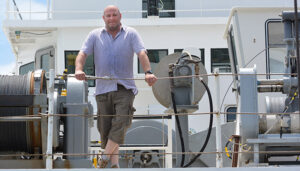A Nose for Nitrogen

Damian Grundle, on board the research vessel Atlantic Explorer, recently joined the BIOS faculty.
Nitrogen is key to life on Earth and in the oceans, an essential building block for all growing plants and animals, from plankton to whales. In excess, it also has harmful environmental consequences, and some forms of nitrogen in the atmosphere are potent contributors to climate change. Damian Grundle, a chemical oceanographer who joined the BIOS faculty in late May, studies nitrogen cycling in the ocean. His current projects involve investigating how dissolved oxygen concentrations, or the amount of gaseous oxygen dissolved in water, impacts the production of the chemical compound nitrous oxide, a gas that reacts with ozone and contributes to global warming.
Before arriving at BIOS, Grundle, 39, spent three years at the Geomar Helmholtz Centre for Ocean Research in Kiel, Germany. At BIOS, he will continue projects established there as he builds his BIOS lab and begins new collaborations, including with a number of fellow BIOS faculty and staff. His current and continuing projects focus on oxygen minimum zones, or oxygen-poor layers of seawater where nitrous oxide is rapidly formed and destroyed by ocean microbes.
Grundle is looking at this nitrous oxide-producing pathway to identify the oxygen thresholds that can induce substantial increases in its production. His work has taken him to coastal Peru and the eastern tropical South Pacific, as well as to newly identified, low-oxygen eddies in the northern Atlantic offshore Cape Verde.
Grundle worked out of BIOS to study nitrogen cycling in the Sargasso Sea as part of his doctoral studies in biogeochemical oceanography at the University of Victoria in Canada, and was also involved with the Oceanic Flux Program. Becoming a full time faculty member at BIOS appealed, he said, “because of the people here whose work complements the type of nitrogen cycling work I plan to conduct, from the overall process down to the microbes that are part of the cycling.”
He noted planned collaborations with long-time BIOS faculty and staff members Nick Bates, Rod Johnson and Rachel Parsons, as well as with Amy Maas and Leocadio Blanco-Bercial, who recently joined the BIOS faculty. “It’s really nice to be a part of this new junior group, coming up together,” he said. (Grundle is joined at BIOS by his wife, Yvonne Sawall, a postdoctoral scholar in benthic ecology working on coral reefs with faculty member Eric Hochberg).
Grundle, who was born in Australia but grew up in England and Canada, became interested in oceanography as a child. “My dad subscribed to National Geographic magazines and I would read the marine science articles,” he said. “Friends remind me that when I was a little boy, I talked about wanting to be an oceanographer, and as I grew marine science and chemistry became my focus.”
He initially studied primary production in the surface waters of the ocean, and how nitrogen cycles in this area of the ocean. Then about eight years ago, while he was working in the subarctic Pacific off the west coast of Canada, he was contacted by Roxane Maranger (University of Montreal), who he had been introduced to through his doctoral advisor S. Kim Juniper (University of Victoria). “Hey, I think it would be pretty cool to look at nitrous oxide out here as well,” he recalled her saying. The more he learned, the more excited he became about how nitrous oxide is produced and cycled in the ocean, processes that determine when, where, and how much potent gas is delivered to the atmosphere.
“It was interesting to me to see how it was mixed daily on the surface, but as you got deeper into the water it required understanding what had happened to that parcel of water over much longer periods of time,” he said. “We were trying to understand what happened to that parcel of water, in terms of nitrous oxide production and related environmental conditions, since it was last in contact with the atmosphere. We are talking over time scales of months to years. We needed to understand how these waters transformed and this challenge peaked my interest.”
Grundle uses multiple platforms for his research to trace one form of nitrogen to another, including a suite of ships that includes the BIOS-operated research vessel Atlantic Explorer (“one of the best crews I have ever been to sea with,” he noted). He also relies on underwater gliders, equipped with nitrate and oxygen sensors, most recently in the eastern tropical North Atlantic to help locate low-oxygen eddies.
“Having Ruth Curry here at BIOS, with her glider fleet, and her experience really helps to round things out for my work,” he said. “Changes happen fast in the upper portions of the water column, and while having shipboard measurements every few weeks or month at the Bermuda Atlantic Time-series Study (BATS) is fantastic, the gliders are able to measure changes in the concentrations and distributions of nitrogen and oxygen at very high resolutions, and this allows us to fill in the gaps between cruises, and provides more spatial context.”
His work relies on mass spectrometers and other forms of newer spectroscopy analyzers for measuring isotopes at BIOS, and he will be establishing his lab with specialized equipment and instruments in the months ahead. “I already have a lot of samples ready for analyses from cruises over the last year, and from cruises happening this year,” he said. “I’m ready to hit the ground running.”
